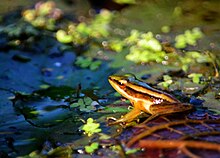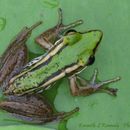Description
provided by AmphibiaWeb articles
Rana erythraea is sexually dimorphic, with adult females reaching a maximum size of 78 mm SVL, and males reaching a maximum of 48 mm in SVL (Brown and Alcala 1970). Dorsal coloring varies from light to dark green and the ventral side is generally whitish, although blue morphs have also been reported (as for some other species of ranids; see Berns and Uhler 1966, and the Comments section below). R. erythraea has cream colored dorso-lateral folds that are sometimes bordered with black. Limbs are yellowish with irregular spotting. This species has smooth skin, and long, free fingers that dilate into minute discs with grooves. It has long hindlimbs. The inner metatarsal tubercle is present, but the outer metatarsal tubercle is absent (Inger and Stuebing 2005). Males are much smaller than females (Iskandar 1998), and breeding adult males have velvety yellow nuptial pads on the first finger, extending from the wrist to the end of the first metacarpal (Inger and Greenberg 1963).This species, like a number of other ranid species (Berns and Uhler 1966), isnormally green-colored but occasionally has blue morphs. Skin chromatophores areresponsible for frog coloration and contain three layers: xanthophores,iridophores, and melanophores. Xanthophores contain yellow pigment. Iridophores contain reflecting platelets full of crystalline deposits andscatter light so that shorter (blue) wavelengths are reflected. Melanophoresabsorb longer wavelengths of light. Since green arises from a combination ofblue and yellow, frogs (or body parts) that lack xanthophores appear blue(Bagnara et al. 2007).For more information on the basis of blue coloration in amphibians (bothadults and eggs), as well as in other vertebrates, see Bagnara et al. (2007).Other non-ranid amphibians with blue coloration include the blue-spottedsalamander, Ambystomalaterale, and a bluepoison dart frog that was formerly known as Dendrobates azureusbefore it was shown to be a variant of the dyeing poison frog Dendrobatestinctorius by Wollenberg et al. (2006). Specimens from India, Nepal, Myanmar and Bangladesh are now assigned toRana tytleri (Ohler and Mallick 2002).
- Arak, A. (1984). ''Sex and song in Malaysian frogs and toads.'' Malayan Naturalist, 38, 20-24.
- Alcala, A. C. (1955). ''Observations on the life history and ecology of Rana erythraea Schlegel, on Negros Island, Philippines.'' Silliman Journal, 2, 175-192.
- Bagnara, J. T., Fernandez, P. J., and Fujii, R. (2007). ''On the blue coloration of vertebrates.'' Pigment Cell Research, 20, 14-26.
- Berns, M. W., and Uhler, L. D. (1966). ''Blue frogs of the genus Rana.'' Herpetologica, 22(3), 181-183.
- Brown, W. C. and Alcala, A. C. (1970). ''Population ecology of the frog Rana erythraea in Southern Negros, Philippines.'' Copeia, 1970, 611-622.
- Diesmos, A. C., Diesmos, M. L., and Brown, R. (2006). ''Status and distribution of alien invasive frogs in the Philippines.'' Journal of Environmental Science and Management, 9(2), 41-53.
- Diesmos, A., Alcala, A., Brown, R., Afuang, L., Gee, G., Sukumaran, J., Yaakob, N., Leong Tzi Ming, Yodchaiy Chuaynkern, Kumthorn Thirakhupt, Das, I., Iskandar, D., Mumpuni, Inger, R., Stuebing, R., Yambun, P. and Makl 2004. Hylarana erythraea. In: IUCN 2009. IUCN Red List of Threatened Species. Version 2009.2. www.iucnredlist.org. Downloaded on 25 January 2010.
- Inger, R. F., and Greenberg, B. (1963). ''The annual reproductive pattern of the frog Rana erythraea in Sarawak.'' Physiological Zoology, 36, 21-33.
- Ohler, A., Mallick, P. K. (2002). ''Rana (Hylarana) sensu Dubois (1992) in India and the identity of Hylarana tytleri Theobald, 1868.'' Hamadryad, 27, 57-65.
Distribution and Habitat
provided by AmphibiaWeb articles
This species is found throughout much of southeast Asia, at elevations up to 1,200 m above sea level (Diesmos et al. 2004). R. erythraea occurs in Brunei Darussalam, Malaysia (Peninsular Malaysia, Sabah, Sarawak), Cambodia, Lao People's Democratic Republic, Thailand, Vietnam, and Singapore. R. erythraea has also been introduced into Indonesia (Java, Kalimantan/Borneo, Sulawesi: Diesmos et al. 2004) and the Philippines (Diesmos et al. 2006). It is mostly found in thick floating marsh vegetation or bushes, particularly at the edge of ponds (both artificial and natural), rice fields, ditches and marshes, as well as quiet streams (Inger and Greenberg 1963; Diesmos et al. 2004; Brown and Alcala 1970).
Life History, Abundance, Activity, and Special Behaviors
provided by AmphibiaWeb articles
The advertisement call has been described as a "squeaky warble" (Inger and Stuebing 2005). Males call while sitting in water, and in Malaysian populations were found to rarely begin calling before 2200 h (Arak 1984). R. erythraea breeds year-round in both Sarawak (Inger and Greenberg 1963) and in the Philippines (Brown and Alcala 1970; Alcala 1955). This species lays a single clutch of pigmented eggs in stagnant water (Iskandar 1998). Lifespan in two Philippine populations was reported to be a maximum of 4 years, based on mark-recapture data (Brown and Alcala 1970). Males in these populations attained sexual maturity at about 6-7 months post-metamorphosis, developing nuptial pads at a minimum body size of 34-35 mm SVL, and females attained sexual maturity at about 9 months post-metamorphosis, at a body size of at least 50 mm SVL (Brown and Alcala 1970).
Life History, Abundance, Activity, and Special Behaviors
provided by AmphibiaWeb articles
This species is abundant in suitable habitat and stable in population (Diesmos et al. 2004). It is adaptable and can be found near human habitation (Inger and Greenberg 1963). Threats include water pollution from agricultural chemicals and consumption for food by humans (Diesmos et al. 2004). It is sometimes found in the pet trade but collection levels do not appear to be impacting populations (Diesmos et al. 2004). Its range overlaps with several protected areas (Diesmos et al. 2004).
Common green frog
provided by wikipedia EN

Common green frog on top of lilypads and other bog plants.
The common green frog (Hylarana erythraea) is a frog species of in the true frog family Ranidae;[2] some sources still use the old name Rana erythraea. It lives in Southeast Asia and is also known as green paddy frog, red-eared frog or leaf frog.[1] The last name, however, commonly refers to the Neotropical tree frogs which make up the subfamily Phyllomedusinae. These are not closely related to H. erythraea, belonging to family Hylidae instead.
Taxonomy and systematics
Long placed in Rana, it is only as closely related to this genus as is e.g. Amolops. Consequently, the genus Hylarana, of which the common green frog is the type species, warrants re-establishment. Hylarana seems to form a clade together with the similarly revalidated genera Pulchrana and Sylvirana, and presumably also Hydrophylax as well as some species presently placed in Pelophylax (e.g. Kokarit Frog, "P." lateralis).[3]
This frog has confused researchers for a long time, as it resembles tree frogs in habitus. It was initially placed in the tree frog genus Hyla. The junior synonyms of the common green frog are:
-
Hyla erythraea Schlegel, 1837
-
Hylorana erythraea (lapsus)
-
Limnodytes erythraeus (Schlegel, 1837)
-
Polypedates erythraea (Schlegel, 1837)
-
Rana erythraea (Schlegel, 1837)
Description
Male Hylarana erythraea grow to a snout–vent length of 30–45 mm (1.2–1.8 in) and females to 50–75 mm (2.0–3.0 in). Tadpoles are up to 36 mm (1.4 in) in length. They have smooth skin that is bright green above and on sides. Tympanum is distinct.[4]
Distribution and ecology
H. erythraea occurs in Brunei, Cambodia, Indonesia, Laos, Malaysia, Myanmar, Singapore, Thailand, and Vietnam. Introduced populations are found on Sulawesi and the Philippines. The similar frogs from northeastern India and adjacent regions, formerly included here, are now separated as Hylarana tytleri.[1]
Its natural habitats are subtropical or tropical moist lowland forests, subtropical or tropical moist montane forests, freshwater lakes, intermittent freshwater lakes, freshwater marshes, intermittent freshwater marshes, rural gardens, heavily degraded former forest, irrigated land, seasonally flooded agricultural land, and introduced vegetation.[1]
Footnotes
References

- license
- cc-by-sa-3.0
- copyright
- Wikipedia authors and editors
Common green frog: Brief Summary
provided by wikipedia EN

Common green frog on top of lilypads and other bog plants.
The common green frog (Hylarana erythraea) is a frog species of in the true frog family Ranidae; some sources still use the old name Rana erythraea. It lives in Southeast Asia and is also known as green paddy frog, red-eared frog or leaf frog. The last name, however, commonly refers to the Neotropical tree frogs which make up the subfamily Phyllomedusinae. These are not closely related to H. erythraea, belonging to family Hylidae instead.
- license
- cc-by-sa-3.0
- copyright
- Wikipedia authors and editors


 Common green frog on top of lilypads and other bog plants.
Common green frog on top of lilypads and other bog plants.